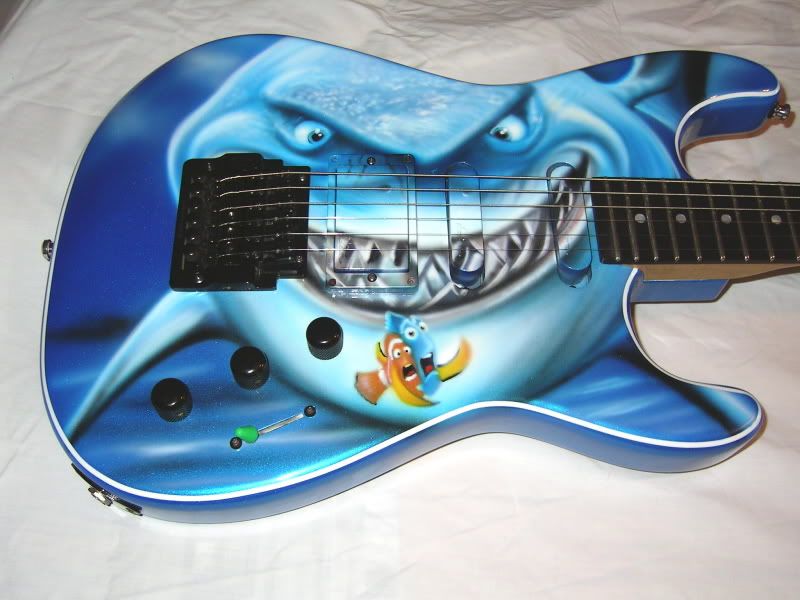Hi,
My name is Dave. I'm new to the JCF, and I just bought my first Jackson. Some have you have met me on the General J/C thread. I have been playing guitar for 30 years, and I'm also a webmaster at RebBeach.com - just so you have some reference on me. I think I've got a vintage goodie, here. You guys seem to really know your stuff, so I was hoping you could help me with a few questions, identifying the origin of my Jackson.
What I have here is very late '86 to very early '87 Jackson custom shop bolt-on Strat. The serial number plate is #1599, San Dimas. The warranty card with it is clearly aged, with an address of Grover Jackson Inc, PO Box 245 San Dimas. The warranty card also has the serial number 1599, on both halves, and is initialed by Mike Eldred on both halves. The model # is just listed as Strat. I have not yet taken the neck off to see what is in the neck pocket.
The guitar is supposedly an all maple body, the neck is Maple / Ebony, is a thin D shape, and is well aged. It has a Kahler Pro trem, pickups are H,S,S, and controls are vol, tone, mid boost, and 5 way toggle.
I got this guitar from a friend over in England (I'm in Maryland), who has been the sole owner since April of 1989. He bought it from a guitar shop run by a friend of his, in Newcastle, England. Before that, it was apparently a trade show guitar that toured around the UK on a Jackson stand, before being sold. Apparently Jacksons were nearly impossible to find in England, at the time.
Also, on the warranty card, the initials B.S. appear in green pen, with the number 9514 next to it. This 9514 number also appeard next to Mike Eldred's initials, but all the serial number spots on the warranty card, and neck plate are #1599.
So, my questions are, any idea who B.S. is, and what the number 9514 represents? Also, is there a defined date of transition from San Dimas to Ontario? I have heard talk of San dimas not actually being a wood shop, but just a PO box address Grover used, any truth to that?
Thanks for any knowledge you can impart with me, I really appreciate it. Here are some photos - the paint job is obviously just a few years old, everything else about it is original - the original paint was straight white.


My name is Dave. I'm new to the JCF, and I just bought my first Jackson. Some have you have met me on the General J/C thread. I have been playing guitar for 30 years, and I'm also a webmaster at RebBeach.com - just so you have some reference on me. I think I've got a vintage goodie, here. You guys seem to really know your stuff, so I was hoping you could help me with a few questions, identifying the origin of my Jackson.
What I have here is very late '86 to very early '87 Jackson custom shop bolt-on Strat. The serial number plate is #1599, San Dimas. The warranty card with it is clearly aged, with an address of Grover Jackson Inc, PO Box 245 San Dimas. The warranty card also has the serial number 1599, on both halves, and is initialed by Mike Eldred on both halves. The model # is just listed as Strat. I have not yet taken the neck off to see what is in the neck pocket.
The guitar is supposedly an all maple body, the neck is Maple / Ebony, is a thin D shape, and is well aged. It has a Kahler Pro trem, pickups are H,S,S, and controls are vol, tone, mid boost, and 5 way toggle.
I got this guitar from a friend over in England (I'm in Maryland), who has been the sole owner since April of 1989. He bought it from a guitar shop run by a friend of his, in Newcastle, England. Before that, it was apparently a trade show guitar that toured around the UK on a Jackson stand, before being sold. Apparently Jacksons were nearly impossible to find in England, at the time.
Also, on the warranty card, the initials B.S. appear in green pen, with the number 9514 next to it. This 9514 number also appeard next to Mike Eldred's initials, but all the serial number spots on the warranty card, and neck plate are #1599.
So, my questions are, any idea who B.S. is, and what the number 9514 represents? Also, is there a defined date of transition from San Dimas to Ontario? I have heard talk of San dimas not actually being a wood shop, but just a PO box address Grover used, any truth to that?
Thanks for any knowledge you can impart with me, I really appreciate it. Here are some photos - the paint job is obviously just a few years old, everything else about it is original - the original paint was straight white.


Comment